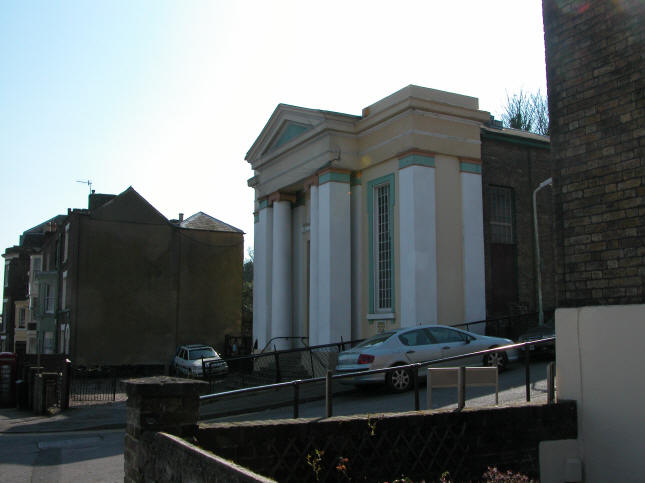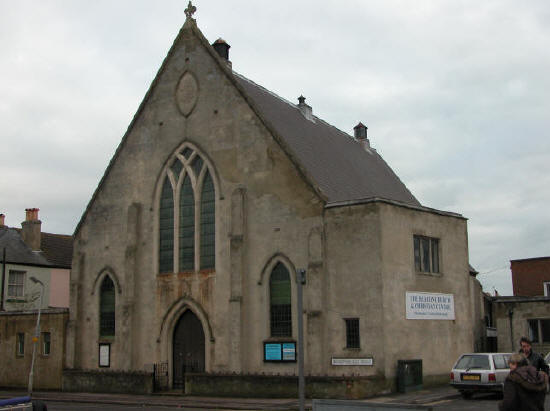| Back |
Buckland Methodist Chapel
|
| |

|
| |
John Wesley established the first Society in Dover
when he preached in the town for the first time on 28th January 1756.
Their first meeting place in
Buckland was
established in 1806; a memorandum of the time records the
details:
“Memorandum
that a certificate under the hands of William Clayton, William Farr, Ann
Russell, Rebecca Popkiss, William Rogers, and William Francis, Dissenters
from the Church of England, commonly called Protestant Dissenters,
certifies that a certain building in the occupation of William Farr, in
the parish of Buckland, in the county of Kent, intended to be set apart
for the worship of Almighty God according to the rules and ceremonies of
the Church of England, was registered in the Consistory Court of
Canterbury according to Act of Parliament, this 6th day of
September, 1806.”
William Farr was my Great-Great-Great-Great-Grandfather.
The location of William Farr's house is unknown. Around 1808/1810
the first Wesleyan chapel in Buckland was built on the East side of London
Road. When the new chapel was built in 1839 the previous building was used
as a day school and Sunday school.
"The larger building on the opposite side of the road, abutting on
Buckland Terrace, built in 1839, was one of the chapels built in
celebration of the centenary of Wesleyan Methodism."
(J.B.J. 1907)
|
| |
Now named the King's Hall, the old chapel adjoining
Buckland Terrace is used for weddings,
parties, etc. The original chapel site is now (2007) occupied by a
chemist's shop. Another Primitive Methodist Chapel was built in Peter
Street in 1860. After the building of the new church in London Road,
this chapel had a rather chequered career before being demolished after
the second World War.
|
| |

|
| |
"Another substantial building in London Road is the Primitive
Methodist Church, built in 1901. This stands just on the border of
Buckland, in part of the Bartholomew Fields. When the Primitive
Methodists first missioned Dover, in 1848, they made their first
converts in Charlton, their first mission room being a cow loft in Brook
Street, not far removed from this new building, which was erected as a
substitute for their first chapel in Peter Street, which they sold, and
which is now converted into a store. The site selected for this
latest and largest place of worship of the Dover Primitive Methodists is
a commanding one, and the building is a credit to the neighbourhood.
Its length and breadth is 61 feet by 37 feet, and its elevation presents
to London Road and Beaconsfield Road arrestive classic features.
The interior affords accommodation for about 600 persons. There
are several subsidiary rooms for classes and for the Sunday school.
The foundation stone was laid on the 6th of May, 1901, by the Mayor of
Dover, Councillor W. J. Barnes, J.P. The builders were two members
of the Society, Mr. Charles Lewis and Mr. G. Brisley. It was
opened on the 1st of January, 1902, by the Mayor, Mr. Alderman Martyn
Mowll, and the members of the Dover Corporation attended in state, the
Mayor delivering an appropriate address on the occasion. The
financing of the undertaking was organised by the Rev. I. Dorricott,
then the minister in charge, who stated that the entire cost of the
building had been £5500, towards which, on the day of the dedication,
they had secured £3000, made up of £1000 from the Primitive Methodist
Mission Fund, £450 from the sale of Peter Street Chapel, and the
remainder derived from local subscriptions." (J.B.J.
1907)
|
| |
The church, opened on New Year's Day 1902, was extended
in 1928. It was damaged in the second World War and part of it had
to be demolished. My father's sister used to teach at the
Sunday school and my mother played the organ; that is how my parents first
met. On 31st August 2003, Buckland Methodist Church was amalgamated with
the Tower Hamlets Chapel and the
United Reform Church to form the Beacon Centre,
so called because of its location on the corner of London Road and
Beaconsfield Avenue.
|
| |
More information
about the Beacon Church and Christian Centre, including some internal
pictures of the three original churches, can be found on the
Beacon Church
website. |

